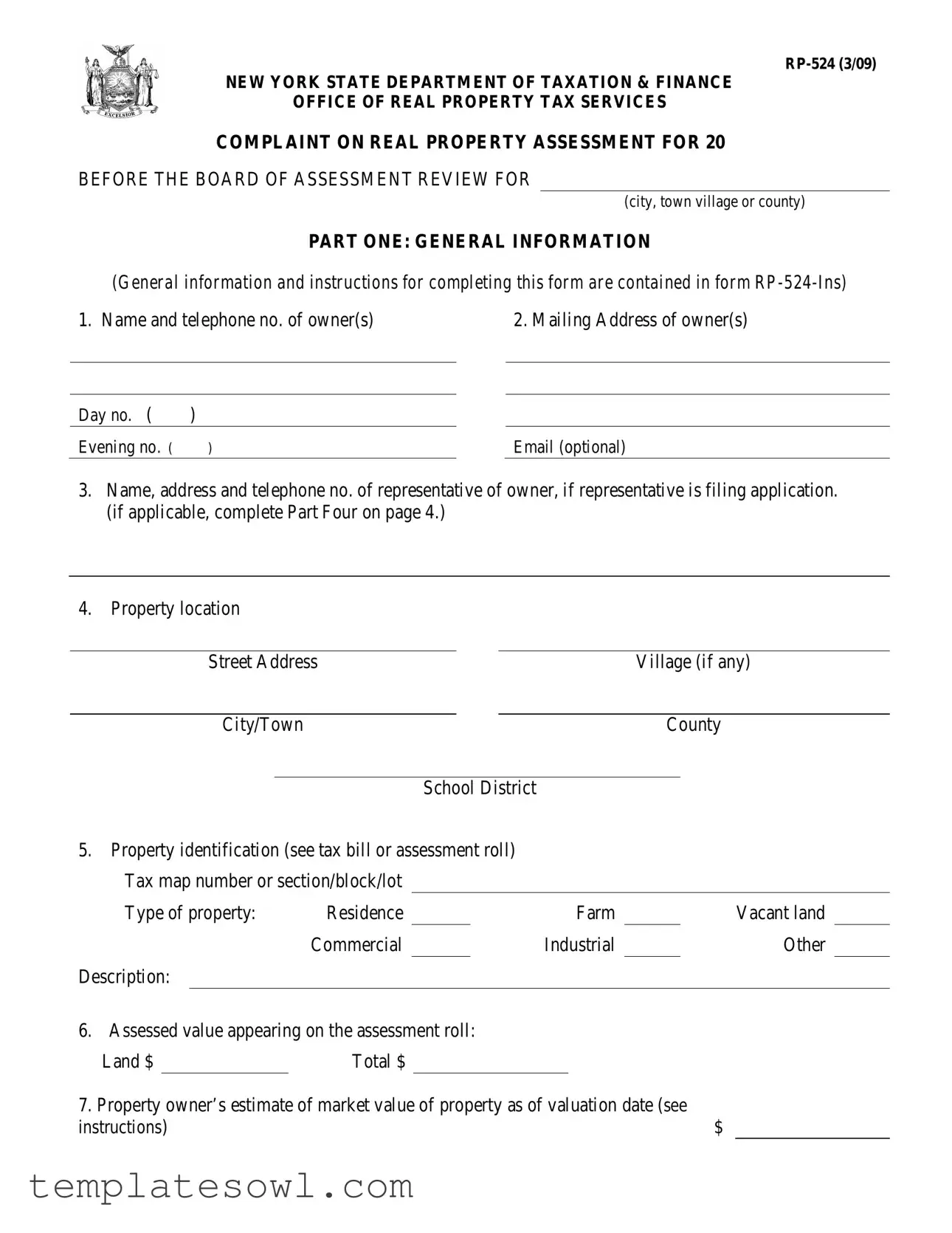RP-524 (3/09)
NEW YORK STATE DEPARTMENT OF TAXATION & FINANCE
OFFICE OF REAL PROPERTY TAX SERVICES
COMPLAINT ON REAL PROPERTY ASSESSMENT FOR 20
BEFORE THE BOARD OF ASSESSMENT REVIEW FOR
(city, town village or county)
PART ONE: GENERAL INFORMATION
(General information and instructions for completing this form are contained in form RP-524-Ins)
1. Name and telephone no. of owner(s) |
|
2. Mailing Address of owner(s) |
|
|
|
|
|
|
Day no. ( |
) |
Evening no. ( |
) |
3.Name, address and telephone no. of representative of owner, if representative is filing application. (if applicable, complete Part Four on page 4.)
4.Property location
Street Address |
|
|
Village (if any) |
|
|
|
|
|
|
City/Town |
|
|
County |
|
|
|
|
|
|
School District |
5.Property identification (see tax bill or assessment roll) Tax map number or section/block/lot
Type of property: |
Residence |
|
|
|
Farm |
|
|
|
Vacant land |
|
|
|
|
Commercial |
Industrial |
|
Other |
Description: |
|
|
|
|
|
|
|
|
|
|
|
|
6. Assessed value appearing on the assessment roll: |
|
|
|
|
|
|
|
Land $ |
|
Total $ |
|
|
|
|
|
|
|
|
7. Property owner’s estimate of market value of property as of valuation date (see |
|
|
|
instructions) |
|
|
|
|
|
|
|
|
$ |
|
|
PART TWO: INFORMATION NECESSARY TO DETERMINE VALUE OF PROPERTY
(If additional explanation or documentation is necessary, please attach)
Information to support the value of property claimed in Part One, item 7 (complete one or more):
|
|
|
|
|
|
|
|
|
|
|
1. |
|
|
Purchase price of property: …….……………………………………….. |
|
$ |
|
a. Date of purchase: |
|
|
|
|
|
|
|
|
b. Terms |
|
Cash |
|
Contract |
|
Other (explain) |
c. Relationship between seller and purchaser (parent-child, in-laws, siblings, etc.):
d. Personal property, if any, included in purchase price (furniture, livestock, etc.; attach list and sales tax receipt):
2.Property has been recently offered for sale (attach copy of listing agreement, if any):
|
|
|
|
|
|
|
|
|
|
|
|
|
|
|
|
|
When and for how long: |
|
|
|
|
|
|
|
|
How offered: |
|
|
Asking price: $ |
|
|
|
|
|
3. |
|
|
Property has been recently appraised (attach copy): |
When: |
|
|
|
By Whom: |
|
|
Purpose of appraisal: |
|
Appraised value: |
$ |
|
|
|
4.Description of any buildings or improvements located on the property, including year of construction and present condition:
5.Buildings have been recently remodeled, constructed or additional improvements made:
Cost $
Date Started:Date Completed:
Complainant should submit construction cost details where available.
6.Property is income producing (e.g., leased or rented), commercial or industrial property and the complainant is prepared to present detailed information about the property including rental income, operating expenses, sales volume and income statements.
7.Additional supporting documentation (check if attached).

PART THREE: GROUNDS FOR COMPLAINT
A.UNEQUAL ASSESSMENT (Complete items 1-4)
1.The assessment is unequal for the following reason: (check a or b)
The assessed value is at a higher percentage of value than the assessed value of other real property on the
a.assessment roll.
The assessed value of real property improved by a one, two or three family residence is at a higher percentage of full (market) value than the assessed value of other residential property on the assessment roll or at a higher
b.percentage of full (market) value than the assessed value of all real property on the assessment roll.
|
|
|
|
|
|
|
|
The complainant believes this property should be assessed at |
% of full value based on one or more of the following |
2. |
(check one or more): |
|
|
|
|
|
a. |
The latest State equalization rate for the city, town or village in which the property is located is |
%. |
|
|
The latest residential assessment ratio established for the city, town or village in which the residential property is |
|
|
located. Enter latest residential assessment ratio only if property is improved by a one, two or three family |
|
b. |
residence |
%. |
|
|
|
|
c. |
Statement of the assessor or other local official that property has been assessed at |
%. |
|
d. Other (explain on attached sheet).
3.Value of property from Part one #7 …………………………............................................................... $
4.Complainant believes the assessment should be reduced to ….............................................................. $
B. EXCESSIVE ASSESSMENT (Check one or more)
The assessment is excessive for the following reason(s):
1.The assessed value exceeds the full value of the property.
a.Assessed value of property ………………………………………………………………………. $
b. |
Complainant believes that assessment should be reduced to full value of (Part one #7) |
$ |
c.Attach list of parcels upon which complainant relies for objection, if applicable.
2.The taxable assessed value is excessive because of the denial of all or portion of a partial exemption.
a.Specify exemption (e.g., senior citizens, veterans, school tax relief [STAR])
b. Amount of exemption claimed …………………………………………………………………… $
c.Amount granted, if any …………………………………………………………………………... $
d.If application for exemption was filed, attach copy of application to this complaint.
Improper calculation of transition assessment. (Applicable only in approved assessing unit which has adopted
3.transition assessments.)
a.Transition assessment ……………………………………………………………………………. $
b. Transition assessment claimed …………………………………………………………………… $
C. UNLAWFUL ASSESSMENT (Check one or more)
The assessment is unlawful for the following reason(s):
Property is wholly exempt. (Specify exemption (e.g., nonprofit organization))
Property is entirely outside the boundaries of the city, town, village, school district or special district in which it is designated as being located.
Property has been assessed and entered on the assessment roll by a person or body without the authority to make the entry.
Property cannot be identified from description or tax map number on the assessment roll.
Property is special franchise property, the assessment of which exceeds the final assessment thereof as determined by the Office of Real Property Tax Services. (Attach copy of certificate.)
D. MISCLASSIFICATION (Check one)
The property is misclassified for the following reason (relevant only in approved assessing unit which establish homestead and non-homestead tax rates):
Class designation on the assessment roll: …………............
1.Complainant believes class designation should be ………..
2.The assessed value is improperly allocated between homestead and non-homestead real property.
|
|
|
|
|
Allocation of assessed value on assessment roll |
|
Claimed allocation |
Homestead |
$ |
|
$ |
Non –Homestead |
$ |
|
$ |

RP-524 (03/09) |
|
|
|
|
4 |
|
PART FOUR: DESIGNATION OF REPRESENTATIVE TO MAKE COMPLAINT |
I, |
|
, as complainant (or officer thereof) hereby |
designate |
|
|
|
to act as my representative in any and all |
proceedings before the board of assessment review of the city/town/village/county of |
|
for |
purposes of reviewing the assessment of my real property as it appears on the |
(year) tentative assessment |
roll of such assessing unit. |
|
|
|
|
|
|
|
|
|
|
|
|
|
|
|
Date |
|
|
Signature of owner (or officer thereof) |
PART FIVE: CERTIFICATION
I certify that all statements made on this application are true and correct to be best of my knowledge and belief, and I understand that the making of any willful false statement of material fact herein will subject me to the provisions of the Penal Law relevant to the making and filing of false instruments.
|
Date |
|
Signature of owner (or representative) |
|
|
|
|
|
|
PART SIX: STIPULATION
The complainant (or complainant’s representative) and assessor (or assessor designated by a majority of the board of assessors) whose signatures appear below stipulate that the following assessed value is to be applied to the above
described property on the(year) assessment roll: Land $Total $ (Check box if stipulation approves exemption indicated in Part Three, section B.2. or C.1.)
|
Complainant or representative |
|
Assessor |
|
Date |
|
|
|
|
|
|
|
|
SPACE BELOW FOR USE OF BOARD OF ASSESSMENT REVIEW
Disposition |
Unequal assessment |
Excessive assessment |
Unlawful assessment |
Misclassification |
Ratification of stipulated assessment |
No change in assessment |
Reason:_____________________________________________________________________________________
____________________________________________________________________________________________
|
Vote on Complaint |
|
|
All concur |
|
|
|
|
|
All concur except: _______________________ |
against |
abstain |
absent |
|
Name |
|
|
|
|
|
_______________________ |
against |
abstain |
absent |
|
Name |
|
|
|
|
|
|
|
|
|
Decision by |
|
Tentative assessment |
Claimed assessment |
Board of Assessment Review |
Total assessment |
$________________ |
$_________________ |
$_________________________ |
Transition assessment (if any) |
... $________________ |
$_________________ |
$_________________________ |
Exempt amount |
$________________ |
$_________________ |
$_________________________ |
Taxable assessment |
$_________________ |
$_________________ |
$_________________________ |
Class designation and allocation of assessed value (if any): |
|
|
|
Homestead |
$________________ |
$_________________ |
$_________________________ |
Non-homestead |
$________________ |
$_________________ |
$__________________________ |
Date notification mailed to complainant ________________________________




